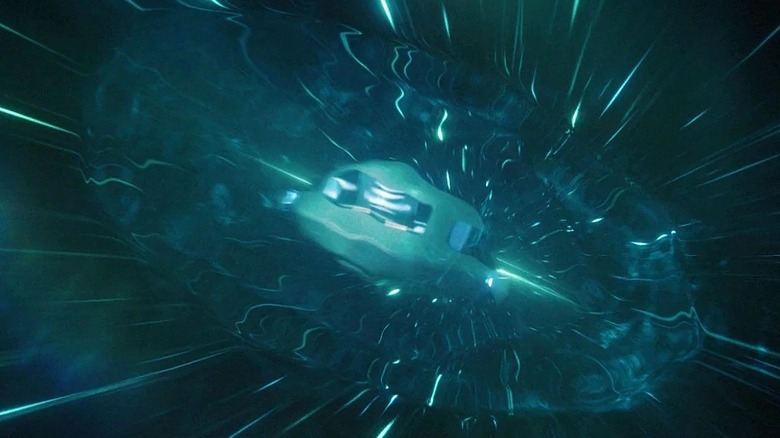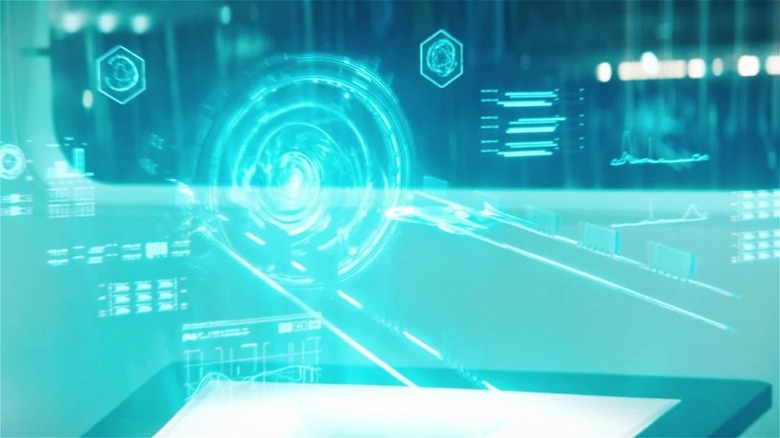Star Trek: What Is A Pathway Drive?
In the world of "Star Trek," access to warp drive technology is so central to space travel and the United Federation of Planets' core mission that the development of a warp drive is the cultural milestone the Federation uses to determine whether species are ready for first contact. Federation warp technology is dependent upon dilithium crystals — a finite resource used to control the antimatter and matter reactors that power a ship's warp drive. Sometime during the 32nd century, the pathway drive is developed to help reduce the Federation's dependence on dilithium in the wake of the Burn, the cataclysmic simultaneous explosion of every warp core in the galaxy when every dilithium crystal suddenly went inert.
While updating Discovery captain Michael Burnam (Sonequa Martin-Green) in the "Star Trek: Discovery" episode "Kobayashi Maru," Federation President Laira Rillak (Chelah Horsdal) tells the Starfleet officer that the pathway drive is just one of the prototypical technologies the Federation is pursuing alongside a "next-generation spore drive." Rillak emphasizes, "There are still quite a few hurdles to overcome, but other technologies, like the pathway drive prototype, have been moving forward nicely. Plans are to install it in Voyager for testing, and I am evaluating my shortlist for the captaincy." But despite this teaser, little information is given about how the technology works at first, leaving it one of the biggest unanswered questions from "Star Trek: Discovery" Season 4.
Although "Star Trek" never gives a breakdown of the science behind the drive, Season 5 does let us see the new technology in action, along with a few hints at how it might work. As demonstrated in "Lagrange Point," the pathway drive can be installed even on smaller vessels like the shuttlecraft UFP-99. It can also be used alongside warp technology, with ships easily transitioning between the two drives.
Pathway Drives could be linked to a pre-Burn Ni'Var program
Aside from Nhan (Rachael Ancheril) mentioning that the pathway drive has to be calibrated before use in "Life, Itself" and the fact that it doesn't require dilithium to run the new FTL propulsion system, very few details about the technology's workings are given in "Star Trek: Discovery." But even if "Discovery" did little to explain the nuts and bolts behind the pathway drive, there's still time for the franchise to explain the new tech. Like "Discovery," Paramount's "Star Trek: Starfleet Academy" will be set in the 32nd century, which means there will be plenty of future opportunities to work out the details and break them down for Starfleet cadets.
As one Redditor posited, the technology could even be linked to a long-abandoned program discussed in the Season 3 episode "Unification III." The technology comes up as Admiral Vance (Oded Fehr) is filling Burnham and Saru (Doug Jones) in on some of the details they missed out on by jumping nearly a millennium forward in Federation history. Vance tells Burnham that even before the Burn, the Federation had faced a dilithium shortage and asked its member planets to develop a better propulsion system.
Ni'Var — the race once known as the Vulcans — developed SB-19, which worked similarly to the spore drive and proved to be the most promising alternative program, but it quickly drew concerns over whether it was safe. The Federation refused to let Ni'Var shutter the program, and so, believing their technology could have caused the Burn, Ni'Var left the Federation, taking their tech with them. Since the Burn ultimately had another cause, it's possible the program was eventually reopened and may be linked to the pathway drive.

